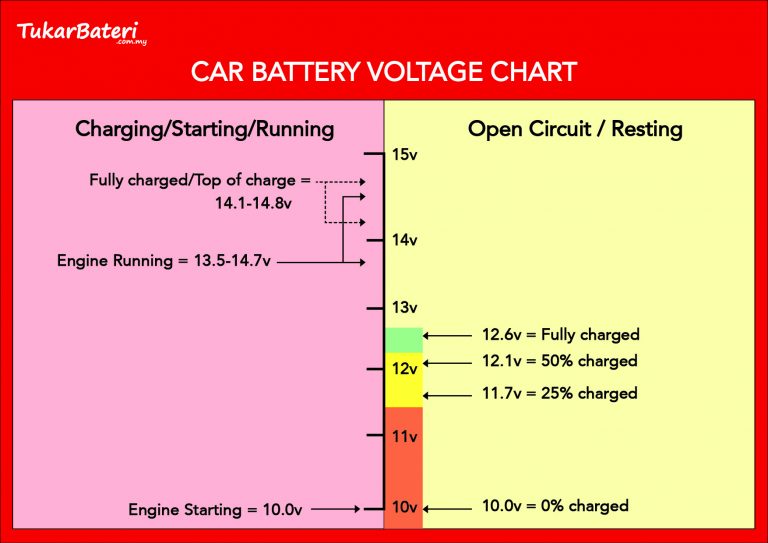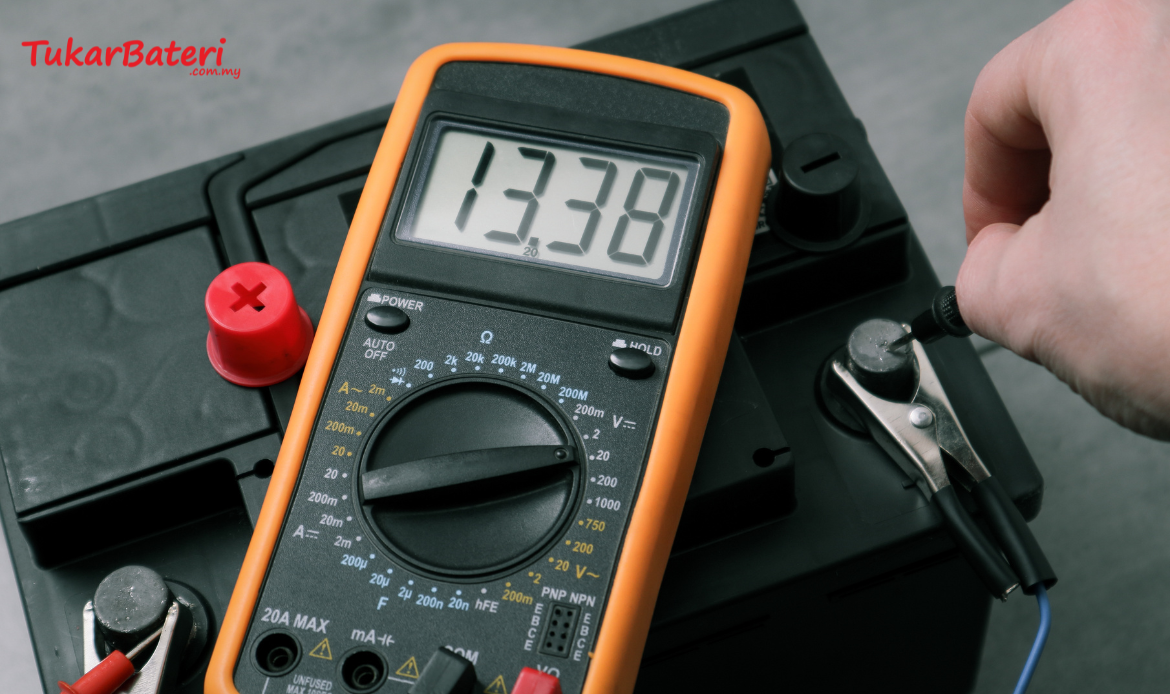Table of Contents
- What Should a Car Battery Voltage Be?
- Factors to determine battery is compatible for your vehicle’s electrical system
- Voltage When the Car is Stopped (Engine Off)
- Voltage When the Car is Running (Engine On)
- Voltage Drop During Starting
- After the Engine Starts
- Monitoring and Maintenance
- Why the car voltage is essential?
- Conclusion
What Should a Car Battery Voltage Be?
- Check the owner’s manual book. It will directly tell you the correct group size for your car.
- Inspect your current old battery in the hood if you can’t find the manual
- Refer to the internet. By entering your car’s year, make, and model, it will show you all the battery options
- The easiest way is just to call us at 011-1608 1608. We will help to figure it out for you!
Factors to determine battery is compatible for your vehicle's electrical system
The voltage of a car battery refers to the electrical potential difference between its positive and negative terminals. This voltage is a crucial indicator of the battery’s state of charge and its ability to start the engine. Car batteries are lead-acid batteries; most passenger vehicles use a 12-volt system. Here’s a breakdown of the voltage levels of a battery’s condition.
- 12.6 volts or above When the engine is off and the battery is fully charged, a typical 12-volt car battery should show a voltage of around 12.6 volts or above. This indicates a healthy state of charge.
- 12.4 volts: This voltage level suggests the battery is about 75% charged. The battery should still be able to start the car, but it may be advisable to recharge it soon to ensure optimal performance.
- 12.2 volts indicates the battery is about 50% charged. At this point, charging the battery is recommended to avoid potential starting problems, especially in cold weather.
- 12.0 volts: Reflects a 25% charge. A battery showing this voltage may not have enough charge to start the engine reliably.
- 11.9 volts or below: A voltage in this range suggests that the battery is discharged or dead. It must be charged immediately or replaced if it fails to hold a charge.

The voltage of a car battery will differ between when the car is running and when it is stopped due to the alternator’s role in the vehicle’s electrical system. Here’s what you can typically expect in each scenario:
Voltage When the Car is Stopped (Engine Off)
- Fully Charged Battery: A healthy, fully charged 12-volt car battery should measure around 12.6 volts or slightly more when the engine is off and the vehicle’s electrical systems are not in use. This voltage indicates the battery’s static charge.
- Partial Charge: Voltages below 12.6 volts but above 12.0 volts can indicate varying degrees of charge, from 75% down to about 25%. A voltage closer to 12.0 volts suggests the battery is weak and may need charging.
- Discharged: If the voltage drops below 12.0 volts, the battery is discharged to a level that might not reliably start the engine.
Voltage When the Car is Running (Engine On)
- Typical Operating Range: With the engine running, the car’s alternator generates electricity and charges the battery. The voltage at the battery terminals should typically be higher than when the engine is off, usually between 13.7 and 14.7 volts. This increased voltage is necessary to charge the battery and power the vehicle’s electrical components (lights, radio, HVAC, etc.).
- Below Normal Voltage: If the voltage with the engine running is below 13.7 volts, it might indicate an issue with the charging system, such as a failing alternator, a loose or corroded battery connection, or a serpentine belt problem.
- Above Normal Voltage: Conversely, a voltage reading above 14.7 volts may suggest an overcharging condition, potentially caused by a faulty voltage regulator or alternator. Overcharging can damage the battery and other electrical components.
Voltage Drop During Starting
When a car starts, the process significantly demands the battery, causing a temporary voltage drop. This drop occurs because the starter motor, which requires substantial electrical power, draws heavily on the battery’s reserves to crank the engine. Here’s what happens to the car battery voltage during starting:
- Normal Range: While cranking the engine, it’s normal for the battery voltage to drop temporarily to around 9.6 to 10 volts. This is expected and indicates that the battery is strong enough to supply the necessary current to the starter motor. The exact voltage can vary based on the vehicle’s starter motor and the battery’s condition.
- Below 9.6 Volts: If the voltage drops below 9.6 volts during starting, it may indicate that the battery is weak, not fully charged, or possibly near the end of its service life. Batteries that struggle to maintain voltage under load may not be able to reliably start the engine, especially in cold weather when engine oil thickens and requires more power to turn the engine over.
After the Engine Starts
- Recovery and Charging: Once the engine starts, the alternator begins charging the battery, and the voltage at the battery terminals should quickly rise to 13.7 to 14.7 volts, indicating that the battery is being charged. This higher voltage is necessary to replenish the battery’s charge after starting and to power the vehicle’s electrical systems while running.
Monitoring and Maintenance
- Battery Health: The behaviour of the battery voltage during starting can be a useful diagnostic tool. A battery that fails to provide adequate voltage during cranking may need to be tested, charged, or replaced.
- Starting System Check: If you experience slow or difficult starting, it’s a good idea to check the entire starting system, including the battery, starter motor, and alternator, and ensure all connections are clean, tight, and corrosion-free.
Why the car voltage is essential?
Car voltage is essential for several reasons, integral to the vehicle’s operation and maintenance. Let’s find out why it matters:
- Engine Start: The initial power needed to start your car comes from the battery. If the voltage is too low, the starter motor won’t have enough energy to crank the engine, leaving you stranded.
- Electrical System Health: Modern vehicles rely heavily on electronics for features ranging from safety systems to comfort and entertainment. Adequate voltage ensures these systems function correctly without glitching or failing.
- Battery Lifespan: Monitoring your car’s voltage can warn you early about battery health. A consistently low voltage might indicate a failing battery, poor electrical connections, or a malfunctioning alternator, allowing you to address the issue before it leads to a breakdown.
- Fuel Efficiency and Performance: The voltage directly impacts the efficiency of the vehicle’s electrical components, including the fuel injection system. Proper voltage ensures optimal fuel combustion, enhancing performance and fuel efficiency.
- Safety: Proper voltage levels ensure that safety features like ABS, airbags, and traction control systems have the power to operate correctly, especially in critical situations.
- Prevents Electrical Overload: The car’s voltage regulator ensures that the voltage level remains within a safe range. Too high a voltage can damage electrical components and the battery, while too low a voltage might not power them sufficiently.
Maintaining the right voltage in your car is crucial for ensuring that the vehicle starts reliably, performs well, maintains its fuel efficiency, and ensures the longevity and reliability of its electrical systems. It’s a key aspect of vehicle maintenance that can prevent minor issues from becoming major problems.
Conclusion
In conclusion, car batteries are crucial components of vehicles, serving as the power source for starting the engine and running the electrical systems. They operate based on electrochemical reactions, converting stored chemical energy into electrical energy. The average lifespan of a car battery typically ranges from 3 to 5 years, but with proper maintenance and care, it can be extended. Factors such as climate, driving habits, and the quality of the battery itself significantly influence its lifespan. Advancements in battery technology and the development of high-quality batteries offer the potential for extended lifespans, making it possible for a car battery to last up to 10 years with the right care and maintenance. Regular inspections, cleaning of terminals, and ensuring proper charging are essential practices to maximize the battery’s performance and longevity.

